Missions to Jupiter
Pioneer 10 and Pioneer 11
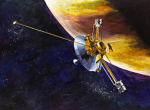 |
Launched in March 1972, Pioneer 10 was the first spacecraft to visit Jupiter when it flew by the gas giant in December 1973 on its way to the farthest regions of the Solar System. Its twin probe, Pioneer 11, made its closest approach to Jupiter on December 1974. Pioneer 10 obtained the first direct images of Jupiter and its moons, measured the planet's magnetic field and radiation environment, and studied its atmosphere and interior. Pioneer 11 was the first mission to make direct observations of the planet's polar regions.
Voyager 1 and Voyager 2
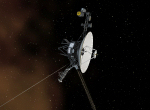 |
The Voyager twin missions were launched in late 1977 and flew past Jupiter in 1979. Scientists used the over 52 000 photos captured by the Voyager 1 and Voyager 2 spacecraft to unveil some of Jupiter's most spectacular weather systems and find evidence of active volcanism on Io. After more than 40 years, both missions are still active and studying the heliosphere and interstellar space. As of December 2017, Voyager 1 is more than 140 astronomical units (21 billion km) from the Sun, farther than any other human-made object has ever been.
Galileo
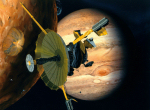 |
Launched in October 1989, Galileo became the first spacecraft to orbit Jupiter when it arrived at the gas giant in December 1995. It carried a probe that was dropped into the planet's atmosphere to study that environment. The mission made significant discoveries about Jupiter and its moons, including magnetic-field measurements that provided evidence of liquid salty oceans underneath the surface of the icy satellites. In 1994, on its way to Jupiter, Galileo observed the collision of Comet Shoemaker-Levy 9 with the planet. The mission ended with the spacecraft deliberately plunging into Jupiter's atmosphere in September 2003 to avoid contamination of the Galilean moons.
Ulysses
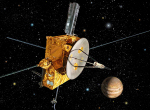 |
Ulysses, a NASA-ESA mission, was a space probe launched in 1990 to study the Sun. En route to its operational orbit around the Sun, it arrived at Jupiter in February 1992, where it made a swing-by manoeuvre to adjust its orbit. The spacecraft used Jupiter for another gravity-assist manoeuvre in 2004. During both of these fleeting journeys through the Jovian system, Ulysses measured the planet's magnetosphere.
Cassini-Huygens
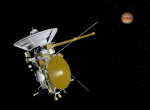 |
The NASA/ESA/ASI Cassini-Huygens spacecraft launched in October 1997 and visited Jupiter on its way to Saturn, its main target. It made the closest approach to Jupiter in December 2000, collecting about 26 000 images of the planet and discovering its atmospheric circulation. The inbound and outbound trajectories allowed scientists to observe the planet daytime and nighttime, and coordinated observations with Earth-orbiting spacecraft such as the Hubble Space Telescope and with the Galileo spacecraft already in orbit around Jupiter provided a rich science harvest. Cassini-Huygens continued on to Saturn where it arrived in 2004, deployed the Huygens probe to land on Titan in January 2005, and then spent 13 years undertaking an extensive exploration of the Saturnian system, the rings and satellites, before the mission ended in September 2017.
New Horizons
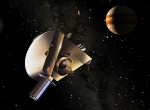 |
The NASA New Horizons mission launched in January 2006 and flew by Jupiter in February 2007, using the planet's powerful gravity to reduce its journey time to Pluto, where it arrived in July 2015. During its time in the Jovian system the mission captured stunning photos of the gas giant revealing a dynamic planet that had changed since previous mission visits. Among the treasures returned were a nighttime view of auroras, the detection of lightning near the planet's poles, and discovery of clumps of material in the main ring of the planet, studies of Jupiter's weather layer, an erupting volcano on Io, and ice maps of Europe and Ganymede.
Juno
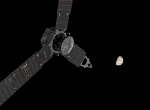 |
Juno, a NASA mission launched in August 2011, is the second spacecraft to orbit Jupiter and study the planet's composition, atmosphere, gravity and magnetic field in detail. It entered a polar orbit of Jupiter in July 2016 and the nominal mission is expected to be completed by July 2018. The mission's main goals are to find clues about Jupiter's formation and evolution, as well as to explore the planet's deep atmosphere. Juno will also shed light on Jupiter's internal structure and rotation, determine how vast its magnetic field is, and how features in the atmosphere relate to the movements in the planet's interior. Already, Juno has revealed that Jupiter's magnetic fields and aurora are bigger and more powerful than originally thought and that the distinctive bands of the planet's cloud tops extend deep into the planet's interior.
